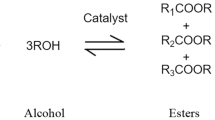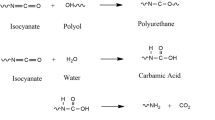Abstract
Due to harmful impact of petroleum-based fluids and lubricants on the environment and Mankind, vegetable oil-based fluids with incorporation of eco-friendly nanostructures have a great potential to be an alternative lubricant if it possesses proper thermal transport and physico-chemical characteristics. In this study, thermal conductivity, and viscosity performance of vegetable nanolubricants, developed from soybean oil and sunflower oil, modified with homogeneous dispersion of magnesium oxide (MgO) nanostructures were evaluated at various filler fractions (0.01, 0.05, 0.10 and 0.25 wt%) over diversetemperatures. For thermal conductivity evaluation, a transient hot wire (THW) methodology was employed. It is observed that for MgO nanolubricants, thermal conductivity increased as a filler fraction and temperature were increased, reaching a maximum of 22% improvement at 0.25 wt% reinforcement at 50 °C. On the other hand, the viscosity showed a consistent behavior as a function of nanostructures filler fraction and decreased significantly in response to increased evaluating temperature.
Graphical abstract





Similar content being viewed by others
References
L.F. Chuah, J.J. Klemeš, S. Yusup, A. Bokhari, M.M. Akbar, A review of cleaner intensification technologies in biodiesel production. J. Clean. Prod. 146, 181–193 (2017). https://doi.org/10.1016/j.jclepro.2016.05.017
J.J. Taha-Tijerina, R. Calderón, B. Rodríguez, Optimization and nanoreinforcements of lubricant Concentration for steel sheet forming process. Int. J. Mod. Manuf. Technol. 13(2), 137–142 (2021). https://doi.org/10.54684/ijmmt.2021.13.2.137
R.A. Kazeem, D.A. Fadare, O.M. Ikumapayi, A.A. Adediran, S.J. Aliyu, S.A. Akinlabi, T.C. Jen, E.T. Akinlabi, Advances in the application of vegetable-oil-based cutting fluids to sustainable machining operations: a review. Lubricants 10(4), 69 (2022). https://doi.org/10.3390/lubricants10040069
J.J. Taha-Tijerina, S. Shaji, S.K. Sharma, M.I. Mendivil-Palma, K. Aviña, Tribological and thermal transport of Ag-vegetable nanofluids prepared by laser ablation. Appl. Sci. 10(5), 1779 (2020). https://doi.org/10.3390/app10051779
K.M.B. Karthikeyan, J. Vijayanand, K. Arun, V.S. Rao, Thermophysical and wear properties of eco-friendly nano lubricants. Mater. Today Proc. 39, 285–291 (2021). https://doi.org/10.1016/j.matpr.2020.07.128
I.P. Okokpujie, L.K. Tartibu, J.E. Sinebe, A.O.M. Adeoye, E.T. Akinlabi, Comparative study of rheological effects of vegetable oil-lubricant, TiO2, MWCNTs nano-lubricants, and machining parameters’ influence on cutting force for sustainable metal cutting process. Lubricants 10(4), 54 (2022). https://doi.org/10.3390/lubricants10040054
Ş Şirin, T. Kıvak, Performances of different eco-friendly nanofluid lubricants in the milling of Inconel X-750 superalloy. Tribol. Int. 137, 180–192 (2019). https://doi.org/10.1016/j.triboint.2019.04.042
J.J. Taha-Tijerina, K. Aviña, N.A. Ulloa-Castillo, D.V. Melo-Maximo, Thermal transport and physical characteristics of silver-reinforced biodegradable nanolubricant. Sustainability 15, 8795 (2023). https://doi.org/10.3390/su15118795
J. Lee, H. Lee, Y.J. Baik, J. Koo, Quantitative analyses of factors affecting thermal conductivity of nanofluids using an improved transient hot-wire method apparatus. Int. J. Heat Mass Transf. 89, 116–123 (2015). https://doi.org/10.1016/j.ijheatmasstransfer.2015.05.064
A. Kalantari, M. Abbasi, A.M. Hashim, Enhancement of thermal conductivity of size-controlled silver nanofluid. Mater. Today Proc. 7, 612–618 (2019). https://doi.org/10.1016/j.matpr.2018.12.015
F. Mashali, E.M. Languri, J. Davidson, D. Kerns, Diamond nanofluids: microstructural analysis and heat transfer study. Heat Transf. Eng. 42(6), 479–491 (2020). https://doi.org/10.1080/0145763220191707388
L. Phor, T. Kumar, M. Saini, V. Kumar, Al2O3-water nanofluids for heat transfer application. MRS Adv. 4(28–29), 1611–1619 (2019). https://doi.org/10.1557/adv.2019.172
M.R. Bindhu, M. Umadevi, M.K. Micheal, M.V. Arasu, N.A. Al-Dhabi, Structural, morphological and optical properties of MgO nanoparticles for antibacterial applications. Mater. Lett. 166, 19–22 (2016). https://doi.org/10.1016/j.matlet.2015.12.020
M. Fernandes, R.B.K. Singh, T. Sarkar, P. Singh, S.R. Pratap, Recent applications of magnesium oxide (MgO) nanoparticles in various domains. Adv. Mater. Lett. 11(8), 1–10 (2020). https://doi.org/10.5185/amlett.2020.081543
H. Majdoubi, A.A. Alqadami, R.E.K. Billah, M. Otero, B.H. Jeon, H. Hannache, Y. Tamraoui, M.A. Khan, Chitin-based magnesium oxide biocomposite for the removal of methyl orange from water. Int. J. Environ. Res. Public Health 20(1), 831 (2023). https://doi.org/10.3390/ijerph20010831
Y. Singh, G.K. Badhotiya, M. Gwalwanshi, P. Negi, A. Bist, Magnesium oxide (MgO) as an additive to the neem oil for efficient lubrication. Mater. Today Proc. 46, 10478–10481 (2021). https://doi.org/10.1016/j.matpr.2020.12.1181
M. Gamal, M.S. Radwan, I.G. Elgizawy, M.H. Shedid, Experimental studies on thermophysical properties of ethylene glycol/water-based MgO nanofluids. J. Phys. Conf. Ser. 2299, 012022 (2022). https://doi.org/10.1088/1742-6596/2299/1/012022
H. Xie, W. Yu, W. Chen, MgO nanofluids: higher thermal conductivity and lower viscosity among ethylene glycol-based nanofluids containing oxide nanoparticles. J. Exp. Nanosci. 5(5), 463–472 (2010). https://doi.org/10.1080/17458081003628949
G. Żyła, Viscosity and thermal conductivity of MgO–EG nanofluids: experimental results and theoretical models predictions. J. Therm. Anal. Calorim. 129, 171–180 (2017). https://doi.org/10.1007/s10973-017-6130-x
M. Anish, T. Arunkumar, B. Kanimozhi, J. Jayaprabakar, N. Beemkumar, V. Jayaprakash, Experimental exploration and theoretical certainty of thermal conductivity and viscosity of MgO-therminol 55 nanofluid. Energ. Source Part A 41(4), 451–467 (2018). https://doi.org/10.1080/1556703620181520329
M. Esfe, M. Afrand, A. Karimipour, W.M. Yan, N. Sina, An experimental study on thermal conductivity of MgO nanoparticles suspended in a binary mixture of water and ethylene glycol. Int. Commun. Heat Mass Transf. 67, 173–175 (2015). https://doi.org/10.1016/j.icheatmasstransfer.2015.07.009
R. Padmini, K.P. Vamsi, M.R.G. Krishna, Effectiveness of vegetable oil based nanofluids as potential cutting fluids in turning AISI 1040 steel. Tribol. Int. 94, 490–501 (2016). https://doi.org/10.1016/j.triboint.2015.10.006
J.J. Taha-Tijerina, K. Aviña, J.M. Martínez, P.Y. Arquieta-Guillén, M. González-Escobedo, Carbon nanotori structures for thermal transport applications on lubricants. Nanomaterials 11(5), 1158 (2021). https://doi.org/10.3390/nano11051158
A.V. Minakov, V.Y. Rudyak, M.I. Pryazhnikov, Systematic experimental study of the viscosity of nanofluids. Heat Transf. Eng. 42(12), 1024–1040 (2020). https://doi.org/10.1080/0145763220201766250
W.K. Shafi, M.S. Charoo, An overall review on the tribological, thermal and rheological properties of nanolubricants. Tribol. Mater. Surf. Interfaces 15, 20–54 (2020). https://doi.org/10.1080/1751583120201785233
W. Ahmed Abdalglil Mustafa, F. Dassenoy, M. Sarno, A. Senatore, A review on potentials and challenges of nanolubricants as promising lubricants for electric vehicles. Lubr. Sci. 34(1), 1–29 (2022). https://doi.org/10.1002/ls.1568
M. Hothar, Z. Wu, B. Sundén, Thermal conductivity of ionic liquid-based nanofluids containing magnesium oxide and aluminum oxide nanoparticles. Heat Transf. Eng. 43(21), 1806–1819 (2021). https://doi.org/10.1080/0145763220212016133
H.K. Judran, A.G.T. Al-Hasnawi, F.N. Zubaidi, W.A.K. Al-Maliki, F. Alobaid, B. Epple, A high thermal conductivity of MgO-H2O nanofluid prepared by two-step technique. Appl. Sci. 12(5), 2655 (2022). https://doi.org/10.3390/app12052655
J.J. Taha-Tijerina, K. Aviña, V. Padilla-Gainza, A. Akundi, Halloysite reinforced natural esters for energy applications. Lubricants 11(2), 65 (2023). https://doi.org/10.3390/lubricants11020065
A. Utomo, N.J. Alderman, G.A. Padron, N.G. Özcan-Taşkın, Effects of particle concentration and dispersion rheology on the breakup of nanoparticle clusters through ultrasonication. Chem. Eng. Res. Des. 191, 301–312 (2023). https://doi.org/10.1016/j.cherd.2023.01.041
A. Asadi, F. Pourfattah, Heat transfer performance of two oil-based nanofluids containing ZnO and MgO nanoparticles; a comparative experimental investigation. Powder Technol. 343, 296–308 (2019). https://doi.org/10.1016/j.powtec.2018.11.023
A. Kotia, P. Rajkhowa, G.S. Rao, S.K. Ghosh, Thermophysical and tribological properties of nanolubricants: a review. Heat Mass Transf. 54, 3493–3508 (2018). https://doi.org/10.1007/s00231-018-2351-1
Acknowledgments
Authors gratefully acknowledge the support received by Dr. Karen Lozano and her research group, the University of Texas Rio Grande Valley and the National Science Foundation under DMR PREM Grant 2122178.
Funding
This research received no external funding.
Author information
Authors and Affiliations
Corresponding author
Ethics declarations
Conflict of interest
The authors declare no conflict of interest.
Additional information
Publisher's Note
Springer Nature remains neutral with regard to jurisdictional claims in published maps and institutional affiliations.
Rights and permissions
Springer Nature or its licensor (e.g. a society or other partner) holds exclusive rights to this article under a publishing agreement with the author(s) or other rightsholder(s); author self-archiving of the accepted manuscript version of this article is solely governed by the terms of such publishing agreement and applicable law.
About this article
Cite this article
Taha-Tijerina, J., Jogesh, K., Padilla-Gainza, V. et al. Study on thermal transport behavior of magnesium oxide (MgO) nanostructures as lubricant additives in vegetable oils. MRS Advances 8, 969–975 (2023). https://doi.org/10.1557/s43580-023-00607-0
Received:
Accepted:
Published:
Issue Date:
DOI: https://doi.org/10.1557/s43580-023-00607-0




